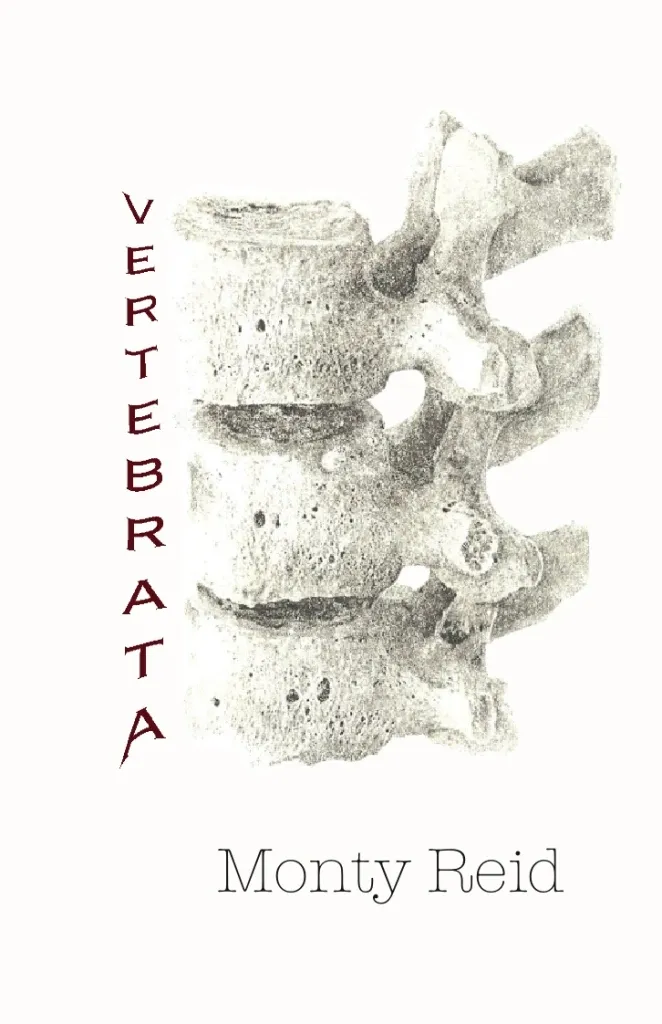Monty Reid, Vertebrata
He’s almost athletic in his prowess to extend verse to a whole host of subjects within a narrow scope to achieve his ultimate effect: omniscience through poiesis.

Vertebrata, Wiktionary explains, is the subphylum containing all vertebrates, animals with backbones.
This chapbook came out with James Hawes’ Turret House Press in 2024, cover design Suzanne Hill. The cover features 3 vertebra in an art style that simultaneously represents macro photography, 3D rendering, and medical textbook illustration, almost like something you would see in the graphic effects of the opening of the TV show House MD (it’s never lupus!).
The title of the work appears vertically in a warped serif typeface, all caps, with author name in tasteful light serif horizontally underneath the artwork.
Inside the cover, the title of the book is stylized quite differently, with different letters taking on various typefaces, giving it a sort of animated slot machine or collage effect.
Monty Reid’s Acknowledgements section simply states:
These poems have appeared in the Chaudiere Books blog, +doc, and Typescript. Many thanks to rob mclennan, Julian Day and Theresa Smalec.
Author bio appears the next page over, which I’ll try to reiterate sparingly in a single telegrammatic sentence: Monty Reid, Saskatchewanian, 25 years in Ottawa, dozen books of poetry, over 20 chapbooks, Lampman winner, three time Stephansson winer, three time GG shortlister.
Each poem of this chap is titled after the corresponding vertebrae, from the nape down to the coccyx, so cervical, thoracic, lumbar, sacrum.
And this is my first time reading Monty Reid despite his illustrious volume of output.
The chap opens: for the doctors
The first poem:
Cervical Vertebra 1 (Atlas)
The weight of the brain
sits on a flat ring of bone
that is only partially bone.
At the top bone, the atlas
condemned to carry
the weight of the world
completely.
Maybe I need to come up with a new term of poetics in my loosely ongoing headcanon, such as fun facts poem, which is certainly the tone this opening poem suggests for the whole of the book.
It’s a fun fact that ends in a pun, it’s double the fun, really.
Turning the page we are greeted with CV3 and CV4:
CV3
Articulates at the Luschka joints.
Little Germanic teeth
subject to degeneration.
And the foramen
little Latinate windows
gradually closing themselves.
And the nerves die
twitching with their languages.
Their little languages.
CV4
Severe stenosis
as per the MRI.
This is a poem about the failure
of form.
Isn’t that a fantastic line? It works on every level. I know, I know, that’s the whole point, but did you ever think you could learn anatomy through verse? Phenomenal.
Basically, I want to excerpt every poem for this review.
Monty Reid makes learning fun. You heard it here first, folks.
There is an element of the Sisyphean in talking about one’s spine. This book certainly demonstrates that.
This book is not only the story of one poor former Saskatchewaner never getting the healthcare he needed when he was young (the poem goes on to state his chiropractor picked him up, shook him, and said that should do it), leading to this thoracic issue in his later life, or slipped disc, or what have you.
He goes on to explain all the phenomena associated with vertebrae, including the whole biblical thing about ribs, for what it’s worth.
The etymology, history of words is explained, various elements of aging included, and personal anecdotes as well.
As far as my expectations for this work, I did not see this coming. But it’s an unexpected joy.
Monty Reid may have proven himself to be a master of spines with this work, but more than that, he seems not to tire himself out hitting all these various fields of knowledge in the process. He’s almost athletic in his prowess to extend verse to a whole host of subjects within a narrow scope to achieve his ultimate effect: omniscience through poiesis.
It makes me wonder what Monty Reid book I’ll read next? Perhaps Dog Sleeps: Irritated Texts.
Is it just me or is there something about a writer with over a dozen books to their name that just makes you wanna read them all?
If you reach out to Turret House Press and manage to get yourself a copy of Vertebrata, I don’t think you’ll be disappointed. You might even get a chuckle out of it, or have something chuckle-worthy to lend to a friend. Money well spent, just my two cents.
Bibelotages Newsletter
Join the newsletter to receive the latest updates in your inbox.



